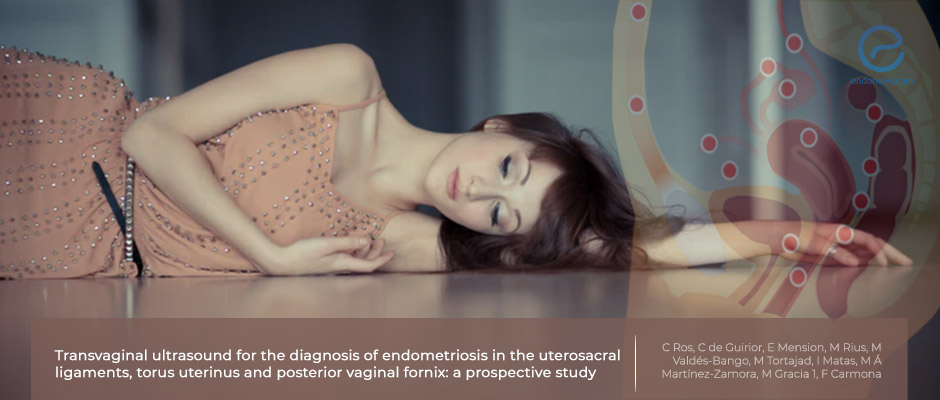Transvaginal Ultrasound Accuracy for Uterosacral Ligament, Torus Uterinus and Posterior Fornix Endometriosis
Sep 8, 2021
A special protocol of TVS is worth predicting deep endometriosis on USLs, TU, and PVF.
Key Points
Highlights:
- Apart from its non-invasive, tolerable, and cost-effective properties, transvaginal ultrasonography is highly accurate for uterosacral ligament, torus uterinus and posterior fornix endometriosis diagnosis.
Importance:
- Implementing the techniques detailed in this study will improve the sonographic detection of deep endometriosis during preoperative assessment.
What's done here:
- This is a prospective "diagnostic accuracy" study examining women scheduled for laparoscopic endometriosis surgery.
- A specific transvaginal sonography protocol (IDEA protocol) was performed by two expert sonographers on 172 patients.
- Demographic data and symptoms were collected, and surgical-pathologically confirmed endometriosis were compared with transvaginal ultrasonography data.
- The presence of adenomyosis, endometrioma and rectosigmoid endometriosis were also assessed and compared.
- The accuracy, specificity, sensitivity, positive and negative predictive values, positive and negative likelihood ratio were assessed following STARD guidelines.
Key Results:
- Presurgical sonographic findings revealed deep endometriosis 58% in uterosacral ligament, 47% in torus uterinus and 16% in posterior vaginal fornix.
- Surgical histopathological findings demonstrated deep endometriosis 51% in uterosacral ligament, 50% in torus uterinus and 13% in posterior vaginal fornix.
- Presurgical sonographic endometrioma was present in 50%, rectosigmoid involvement was detected in 49% and anterior compartment involvement was 5.8%.
- Surgical histologic confirmation of endometrioma was in 44.2%, rectosigmoid involvement was confirmed in 44% and anterior compartment involvement was 7%.
- The global accuracy of transvaginal sonography was 90%, with a sensitivity of 91% and a specificity of 87%.
- Accuracy, sensitivity, specificity of transvaginal ultrasonography were high in predicting endometriosis in above deep locations.
- There was a significant association between the presence of endometriosis in these deep locations and rectosigmoid endometriotic nodules.
- Concerning the symptoms, dyschezia was strongly associated with deep endometriosis in above locations, independent of rectosigmoid involvement.
Limitations:
- This study was conducted in a tertiary referral center with a high prevalence of deep endometriosis, the results may not be generalized.
- The classification of the uterosacral ligament was not according to the most recent proposal of Leonardi.
- The technique and expertise of both sonographers and surgeons and study being from a single center is its strength.
Lay Summary
The accuracy of transvaginal ultrasonography for the diagnosis of deep endometriosis depends on the location. The sensitivity is up to 80% when the lesion is in the rectosigmoid, but it decreases up to 66% for the detection of posterior vaginal fornix endometriosi. The difference becomes more relevant for uterosacral ligament, which is the most common site of deep endometriosis.
Ros et al. from University of Barcelona, Spain, aimed to evaluate the diagnostic accuracy of transvaginal ultrasonography in predicting the presence of deep endometriosis of uterosacral ligaments, torus uterinus and, and posterior vaginal fornix. The single-center prospective study included 172 consecutive women with suspected or proven pelvic endometriosis who underwent 4 steps of IDEA examination protocol, which is perfectly detailed in the original paper published in "Ultrasound in Obstetrics & Gynecology".
Patients files, demographic data and symptoms were collected, and surgical-pathologically confirmed endometriosis were compared with transvaginal ultrasonography data; and the presence of adenomyosis, endometrioma and rectosigmoid endometriosis were also assessed.
When presurgical sonographic findings were compared to histopathological diagnosis of surgically excised lesions being gold standard, the global accuracy of transvaginal sonography was 90%, with a sensitivity of 91% and a specificity of 87% in uterosacral ligament, torus uterinus and posterior vaginal fornix located deep endometriosis.
Furthermore, there was a significant association between the presence of endometriosis in these deep locations and rectosigmoid endometriotic nodules. The evaluation of symptoms revealed that dyschezia was strongly associated with the presence of deep endometriosis in above locations, independent of rectosigmoid involvement.
The authors concluded that the real-time transvaginal sonography used in their study demonstrated high accuracy, sensitivity and specificity for the assessment of deep endometriosis in uterosacral ligament. torus uterinus and posterior vaginal fornix; and recommended training for the technique and evaluation in order to increase the diagnostic accuracy in these locations.
Research Source: https://pubmed.ncbi.nlm.nih.gov/34090310/
uterosacral ligament torus uterinus posterior vaginal fornix transvaginal ultrasonography specificity sensitivity endometriosis.

